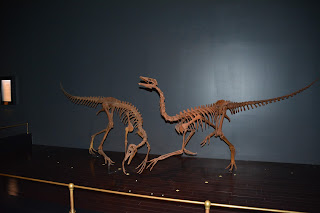The Royal Tyrrell Museum of Paleontology was a fabulous treat to visit today where we viewed one of the world's largest collections of dinosaur skeletons, most of which were discovered in Alberta's badlands.
We were greeted at the Royal Tyrrell Museum by this ground squirrel who was enjoyed someone's abandoned cookie. These little squirrels reminded us of prairie dogs - only smaller.
Main entrance.
Entitled "Black Beauty", this almost complete skeleton of a T-Rex was discovered along the banks of an Alberta river and is one of the best preserved skulls ever found.
Many of the skeletons are found in this "death pose". Theory suggests the flesh decomposed, muscles dried and ligaments tightened, pulling the skeleton into a dramatically arched position. Soon afterwards, sediment buried the body protecting its striking posture for millions of years.
A T-Rex in the Lords of the Land exhibit room.
Large eyes and a slender neck allowed Ornithomimus to scan its surroundings quickly and efficiently. Armed with a sharp, narrow snout, this omnivore was well adapted to peck and rip both flesh and vegetation. It is thought these predators may have preyed on everything from grasses to hadrosaur nestlings.
Triceratops, 66 million years ago.
Albertosaurus - a precursor, and slightly smaller, to T-Rex and found in Alberta.
The Journey Through Time included a Mammoth from the Ice Age, 12 thousand year ago.
Later this afternoon we drove out of town to Horseshoe Canyon, a glacier-carved "U", and did a little hiking in the badlands.
One of the main differences in these badlands from the ones in South and North Dakota is that there were fir trees in the valleys.











Well some of this looks familiar, eh?
ReplyDeleteThe Royal Tyrrell Museum of Paleontology looks like it was fascinating. (I loved the photo of the ground squirrel eating the cookie!) I am saving this blog to show my grandson who can't get enough of anything to do with dinosaurs. I agree, it does seem strange to see fir trees in the badlands. I guess being that much farther north makes a difference. Judy S.
ReplyDelete